What is the best strategy for communicating health care information to a patient who is completely deaf?
Call for an interpreter certified in sign language
Identify the proper medical record documentation of medication administration.
5 mcg/min, Epinephrine, IV, 11/12/2007, 0940
date, time, drug name, dosage, and route of administration
Which guideline is recommended for safely lifting a patient from a seated position?
Stand with feet apart to establish a wide base of support
Which guideline is most effective for reducing the number of nosocomial infections?
Position urinary catheter bags below the level of the patients bladder
Which value represents a normal respiratory rate for a pediatric patient?
25 breaths per minute
According to the American Heart Association (AHA) guidelines, which is the correct rate of chest compressions when administering cardiopulmonary resuscitation (CPR) to a 6-month-old patient?
At least 100 per minute
Which is the most appropriate response to a patient who asks what the term "peritonitis" means?
peritonitis is an inflammation of the abdomen
What route of transmission is responsible for transmitting a disease to a patient through an improperly cleaned x-ray table?
fomite
According to the ARRT Standards of Ethics, a radiographer may be subject to sanctions including revocation of certification for which actions? (Select the three that apply.)
- failing to report a medical error because the patient was unharmed
- performing a medical procedure without appropriate training of supervision
- performing duties while under the influence of illegal drugs or alcohol
Which is the best way to control severe bleeding from a deep laceration of the upper arm?
apply direct pressure to the wound and raise the patients arm above the level of the heart
Consider the contrast media label shown here. What does the "Not for parenteral use" warning mean?
It must be administered orally of rectally
A patient is slumped over in his wheelchair and is non-responsive. After easing the patient to the floor, the radiographer finds no carotid pulse. The patient is experiencing which condition?
Cardiac Arrest.
Cardiac arrest is the complete cessation of heart function. Myocardial infarction is the death of heart tissue due to lack of blood supply.
Which general guideline is the most appropriate for determining when to use standard precautions?
When performing exams on all patients
Which guideline represents the best approach for examining patients who are mentally impaired?
assess each patients ability to follow instructions prior to the exam
When obtaining a blood pressure reading, systolic and diastolic values are determined by monitoring which pulse point?
brachial
Radial and carotid points are commonly used to assess the rate and quality of a patient's pulse.
A trauma patient arrives to the emergency department unconscious with tachycardia and hypotension. The patient has lost a significant volume of blood. The patient is experiencing which condition?
Hypovolemic shock
Which is considered a major contraindication for intravenous urography?
hypersensitivity to contrast media
When transferring a patient with hemiparalysis from a wheelchair to the x-ray table, in which position should the wheelchair be placed?
parallel to the x-ray table, with the patients strong side closest to the table
What are the six right of drug administration that radiographers should follow?
- patient
- drug
- amount
- route
- documentation
- time
Washing hands with soap and water disrupts the chain of infection by which process?
decreasing the number of pathogens present
What is the most appropriate response if a patient asks about the risks of radiation exposure from a CT exam?
A CT results in a much higher radiation dose than x-ray, but your physician believes the benefits outweigh the risks
This image is a medical record entry lacking important information. Place the cursor on the portion of this entry that is incorrect and left click.
All medical record entries must include the printed name and
credentials of the radiographer.
The image shows "M. Stevens"
What precautions should a radiographer take when entering the room of a patient with varicella virus?
Wear a particulate respirator mask, gloves, and gown
Varicella is chickenpox, so airborne and contact precautions
Place the cursor on the contrast media that should be administered for an intravenous urogram and left click.
Isovue
Which condition requires a patient to be placed in a negative pressure room, and healthcare workers to wear respiratory protection when entering?
Tuberculosis
Which example of nonverbal communication is most effective fr helping a patient overcome anxiety and apprehension prior to an exam?
maintain direct but appropriate eye contact with the patient
During a routine radiographic examination, a patient complains of dizziness and appears anxious and diaphoretic. while checking the patients vital signs, the radiographer note a rapid heart rate, shaky hands, and clammy skin. Which is the most likely explanation for this presentation?
hypoglycemia
during the medical history assessment prior to an upper GI study, the patient reports he is taking an AC inhibitor, Vasotec. This suggests the patient is being treated for which condition?
hypertension
Which item must be discarded in a biohazard bag?
bed sheet saturated with blood
What type of shock is caused by a reaction to contrast media?
vasogenic
When a radiographer asks a patient to lie down on the imaging table and the patient complies, which type of consent has the patient given?
Simple consent
Which describes the proper technique for needle insertion during venipunture?
Insert needle into vein at a 15-degree angle with bevel facing upward
Which practices are considered violations of HIPAA? (two)
- accessing medical images of a coworker
- looking up test results of a family member
Which is the most likely result if an exposure is made without the use of a focusing cup?
Increased off focus radiation
Which term refers to the removal of an electron from the orbital shell of an atom?
ionization
How is the process of thermionic emission described?
electrons are released when the filament is heated
which type of interaction results in the production of bremsstrahlung -rays?
a projectile electron slows down near the nucleus of the target atom
Which term is used to describe the intensity of the x-ray beam?
quantity
Quantity refers to the intensity, or total number of x-ray photons in the primary beam.
what is the primary controlling factor for x-ray beam quality?
kVp
Which type of radiation is produced when an outer shell electron fills an inner shell vacancy?
Characteristic
What is the minimum recommended filtration for general diagnostic x-ray units?
2.5 mm Al
In which position should the patient be placed in order to demonstrate the right intervertebral foramina of the cervical spine while minimizing radiation dose to the thyroid gland?
RAO
What is the advantage of using high kVp, low mAs technique with DR systems?
patient exposure decreases
With all other factors remaining the same, a decrease in kVp with cause an increase in which x-ray beam characteristic?
wavelength
Which fluoroscopic mode results in the lowest patient dose?
Digital pulsed progressive
A six year old pediatric patient arrives in the radiology suite for a radiograph of the abdomen. Which st of technical factors provides the best radiation protection?
82 kVp, 7.5 mAs
What is the maximum allowable tabletop intensity in high level control (HLC) fluoroscopic procedures?
20 R/min
A radiographer performs an abdomen examination with a mobile DR system. In order to reduce the likelihood of a repeat exposure, he decides to increase the technical factors slightly more than necessary. Which term refers to this undesirable practice?
Dose creep
Which is the required amount of inherent filtration for general purpose x-ray tubes?
0.5 mm AL equivalent
According to the FDA, what is the maximum air kerma rate for fixed fluoroscopic units?
10 cGy/min
A radiographer stands six feet from the x-ray source when performing a portable chest exam and receives an exposure of 2 mGy. If the radiographer performs a repeat exam using the same technical factors standing at a distance of three feet from the source, how much exposure will be received?
8 mGy
According the inverse square law, when the distance is halved, the exposure increases by a factor of four. In this scenario, the radiographer will receive 8 mGy at a distance of three feet, compared to 2 mGy at a distance of six feet. The equation is old intensity/new intensity equals the square of the new distance/old distance. The other answers result from incorrect application of the inverse square law.
Which factors will impact the radiation barrier calculations for an x-ray room?
(3)
- people in adjoining rooms
- types of exams performed in the room
- how often the room is ued
Which procedures should imaging personnel perform in order to reduce exposure time during fluoroscopic procedures?
(3)
- use the last image hold feature
- use pulsed progressive mode
- reset the cumulative time before the procedure
Which organ has the highest tissue weighting factor?
gonads
The gonads are the most radiosensitive organ, with a weighting factor of 0.20. The weighting factor for both the thyroid and breast is .05. The weighting factor for lung tissue is .12.
Which minimum thickness of lead shielding is required to cover the bucky slot during fluoroscopic exams?
0.25 mm
Which value represents the annual maximum dose limit for exposure to the extremities in medical imaging personnel?
500 mSv
Which is the maximum allowable exposure to the embryo or fetus each month?
0.5 mSv
A 14 year old female patient arrives in the radiology department for a scoliosis series. Which option provides both the bst image quality and lowest radiation dose for this patient?
Employ shadow shields
For which lumbar spine projections should a shaped contact shield be applied to provide protection for the gonads of a male patient? (3)
- L5-S1 lateral spot
- AP
- AP oblique, RPO
How will dose area product (DAP) be affected during a 4 Roentgen exposure is the collimated field is reduced from 8 X 8 cm to 4 X 4 cm?
DAP will be 1/4 of the original
Which statement correctly describes the amount of kinetic energy required for a photon to remove an inner shell electron from its orbit?
The same or greater than the electron binding energy
In the diagnostic energy range, which substances possesses the greatest ability to absorb radiant energy through the process of photoelectric absorption?
bone
Which are by-products of photoelectric absorption?
photoelectric and characteristic photon
Which interaction with matter contributes to the majority of occupational exposure?
compton scattering
Which describes the relationship between LT and RBE?
As LET increases, RBE increases
Which describes a linear, non-threshold dose-response relationship?
No dose may be considered completely safe
Which term is an alternate name for the prodromal stage of ARS?
Initial stage
Which whole body dose most closely approximates the LD 50/30 for humans?
300 rad
The LD 50/30 refers to the whole-body dose that can be lethal to 50% of the population over 30 days; for humans, this dose is reached is between 300 and 400 rad
At which energy range dose photodisentegration occur?
above 10 megaelectron volts (mEv)
For which purpose is gonadal shielding recommended?
To reduce the probability of genetic mutations
Which combination of technical factors is recommended to reduce patient dose?
high kVp low mAs
What is the primary purpose of beam filtration?
To protect patient from low energy x-rays
Patient dose during fluoroscopy can be minimized by which methods? (3)
- restrict beam size
- use larger diameter modes
- use last image hold
When a pregnant patient must undergo a radiographic procedure, which practices will minimize radiation exposure? (3)
- select appropriate exposure factors for the part being imaged
- shield the abdomen and pelvis whenever this does not interfere with the image
- collimate to include only the area of interest
Which method should be the first choice to reduce exposure to the reproductive organs in every radiographic exam?
collimate to include only the anatomy of interest
How should the radiology manager schedule a pregnant radiographer?
Maintain the employees same schedule before declaration of pregnancy
how many millimeters of lead equivalency is recommended for lead aprons worn by pregnant radiographers?
0.5
How should a mobile C-arm fluoroscope be positioned to provide maximum radiation protection to the operator?
With the tube under the patient and as far away from the patient as possible
If all other factors remain constant, how is radiation dose related to SOD?
by the inverse square law
Over the entire gestational period, what is the fetal exposure limit?
0.5 rem (5 millisievert)
Which term means the loss or change of a nitrogenous base in the DNA chain?
Mutation
Which human cell is the most resistant to the effects of radiation?
neurons
Which dose may cause temporary sterility of both males and females?
2 Gy
Biologic damage resulting from the ionization of key atoms causing these molecules to become inactive or functionally altered is much more likely to occur after exposure to which type of radiation?
High LET radiation such as alpha particles
Place the following actions in order of greatest to least impact for reducing occupational exposure during fluoroscopy.
- film badge
- TLD
- OSL
- Pocket ionization chamber
Place the following actions in the order of greatest to least impact for reducing occupational exposure during fluoroscopy.
- Stand behind control panel
- double distance from x-ray source or patient
- cut exposure time in half
- wear a lead apron
Which post processing action is always acceptable?
Annotating with an upright marker to show the patient was in an erect position
How does a wide window width affect an image?
decreases contrast
In CR systems, the photostimulable phosphor plate is made of which material?
Barium Fluorohalide
Which radiopaque marker is image appropriate after micturition has taken place?
Post-void
Which procedure is most effective for reducing localized image blurring caused by involuntary patient motion?
Decrease exposure time
Assuming that AEC is to be used, what backup mAs are sufficient for a large adult AP lumbar spine done at 80 kVp?
100 mAs
The radiographer is using AEC on a sinus examination. The quality control technologist directs the radiographer to repeat the Water's projection with increased contrast. Thus the radiographer changes the kVp from 85 to 72. What change to AEC settings or positioning is needed?
No change
Which x-ray tube orientation represents the correct application of the anode heel effect?
The anode end is positioned toward the head for an AP thoracic spine projection
A lateral lumbar spine image was obtained with a field size of 11X14 inches at 95 kVp and AEC with the center detector selected. The resulting image demonstrates excessive quantum noise. Which is the most likely cause for this appearance?
The patient was not accurately centered
Which effect does switching to the small focal spot size have on a manifest image?
Image unsharpness decreases
Which acronym describes a network of computers that manages digital images?
PACS
How will raising the window level affect the digital image?
increases brightness
A fixed kVp variable mA chart recommends exposure factors of 70 kVp and 32 mAs for an AP abdomen projection on an average-size patient. Based on this chart, which fixed kVp technique is most appropriate for an AP projection of a double contrast upper GI image?
90 kVp, 8 mAs
15% kVp rule
Which mA station with result in a mAs value of 44 if the exposure time is 0.11 seconds?
400 mA
Which image, when performed according to normal standards, will demonstrate the greatest magnification of the anatomy of interest?
Lateral cervical spine
Which term refers to a graphical representation of pixel values?
Histogram
The collimator light must be aligned to the radiation field within what percent of the SID?
2%
With all other factors remaining the same, which SID results in the greatest exposure to the IR?
40 inches
How are AEC devices for mammo different than those used with diagnostic radiography?
Greater accuracy required
Which set of exposure factors is most likely to provide clear visualization of the upper cervical spine through the mandible when performing an AP wagging jaw projection?
75 kVp 25 mA and 2 seconds
When using digital imaging, which has the greatest influence on contrast?
LUT
The mobile chest image lacks which required element?
anatomical markers
The center of the x-ray beam must be aligned to the center of the bucky tray to within what percent of the SID?
1%
Which mAs setting is most likely to produce quantum mottle?
2.5 mAs
Opening the collimators wider than necessary using digital radiography has which effect on image quality?
increased image noise
Consider these different abdomen images of the same patient. What most likely caused the difference in these images?
Image A was produced at a shorter SID
Image A was blacker, or more dense, so it makes sense that a shorter SI was used.
How does aliasing appear radiographically when using CR?
Two superimposed images, slightly out of alignment
Which is an advantage of digital imaging systems compared to traditional film screen systems?
Improved contrast resolution
One advantage digital systems have over film-screen receptors is improved contrast resolution, or a greater ability to distinguish between structures of similar densities (this is also termed improved dynamic range). Digital systems are no less susceptible to image noise than traditional film-based systems. Spatial resolution is decreased relative to film-screen imaging due to the size of the pixel. Digital systems are more sensitive to scatter radiation than film-screen receptors.
Which mAs value should be selected for a patient measuring 30 cm if 22 mAs is optimal for a patient measuring 25 cm?
44 mAs
When using fixed kilovolts peak techniques, an increase in patient thickness of 4 to 5 cm requires that the mAs be increased by a factor of 2. In this example, an increase of 5 cm would require in increase from 22 mAs to 44 mAs. The other values represent increases of 25%, 40%, and 80%, respectively.
Which scenario causes foreshortening of the anatomy on the image?
The humerus in contact with the IR, the forearm lifted off the image receptor, and the central ray directed perpendicular to the long axis of the humerus
Foreshortening occurs when the part is angled in relationship to the central ray, or when the forearm is lifted off the IR, but the central ray is still directed perpendicular to the long axis of the humerus
Which is the best way to avoid excessive quantum noise when using cassette based digital systems?
Increase the amount of exposure to the IR
Which is a primary advantage of a rotating anode?
less heat is generated at the target
Which factor will have the greatest impact on decreasing recorded detail or spatial resolution?
Motion
At which location is the ionization chamber located in the AEC device?
between the grid and IR
A portable chest x-ray is taken at 56 inches using 12 mAs at 72 kVp. Which technique should the radiographer use if the chest x-ray is repeated in the radiology dept at 72 inches to maintain density?
24 mAs at 72 kVp
In order to maintain density when distance is changed, the radiographer should adjust mAs using the exposure/density maintenance formula (mAs1/mAs2 = D1 squared/D2 squared)
Which technical factor increases the number of x-ray photons reaching the IR?
increase mA
Which term refers to the positive electrode of the x-ray tube?
anode
all other factors remaining the same, how will increasing the SID from 40 to 60 inches affect the appearance of a radiographic image?
decrease magnification
Which device provides the required amount of voltage for x-ray production?
transformer
Which factors affect spatial resolution in digital imaging? (2)
- greater number of pixels
- smaller pixels
Which substance is added to the x-ray tube housing to increase heat dissipation?
oil
Which combination results in an image with the greatest recorded detail?
2 inch object-to-image-receptor-distance (OID), 72 inch source-to-image-receptor-distance (SID), 0.6 mm focal spot size (FSS). Correct
An image of the abdomen demonstrates appropriate density and scale of contrast, but motio blur is present due to peristalsis. If the original image was obtained with a 200 mA station and an exposure time of 0.35 seconds, which set of technical factors will produce a comparable exposure while minimizing motion artifact?
500 mA and 0.14 Seconds
Which device is located in the primary section of the general x-ray circuit?
timer circuit
which device in the x-ray circuit changes alternating current to direct current?
rectifier
which effect does a step up transformer have on voltage and current?
voltage is increased and current is decreased
Which effect will a low SNR have on the appearance of a digital radiographic image?
decreased contrast resolution
SNR is largely dependent on the number of photons available for image formation. Fewer available photons results in a low SNR, which in turn results in higher image noise and decreased contrast resolution.
A radiograph of optimal density is produced at 15 mAs and a SID of 40 inches. Which mAs value is required to produce the same radiographic density if this exam is repeated at an SID of 48 inches?
22
The density maintenance formula, mAs1/mAs2 = D1 squared/D2 squared, provides a method of compensating for changes in SID. In this instance, 15/x = (40)2/(48)2; 1600x = 34,560; x = 34,560/1600 = 22 mAs. The other answers result from math errors.
Which post processing techniques may be used with digital imaging? (3)
- smoothing
- filtering
- electronic masking
Which advantage is gained by increasing the standard SID from 40 to 48 inches?
increased image resolution
Beginning with the patients head in true lateral position, which positioning method is recommended for demonstrating the mandibular body without foreshortening on an axiolateral oblique method of the mandible?
Rotate the patients head 30 degrees toward the IR

Consider this oblique hand image. Which statement correctly describes this image?
The hand is under-rotated
Which lumbar spine structures are best demonstrated with the patient in a 45 degree LPO?
Left Z joints
lumabar intervertebral foramina are shown on laterals
Which type of pathology is defined as inflammation of an outpouching of the colon?
diverticulitis
Diverticulitis is an inflammation of the outpouching of the colon. Diverticulosis is simply the condition of having outpouchings in the colon
The Holmblad method is performed to demonstrate which radiographic appearance?
Open intercondylar fossa
In which position should the patient be placed for insertion of the enema tip during a barium enema procedure?
Sims'
Which body plane is positioned perpendicular to the IR on a lateral chest projection?
Midcoronal plane
Which radiographic appearance results when the anterior surface of the patients elbow is rotated 45 degrees medially for an AP elbow projection?
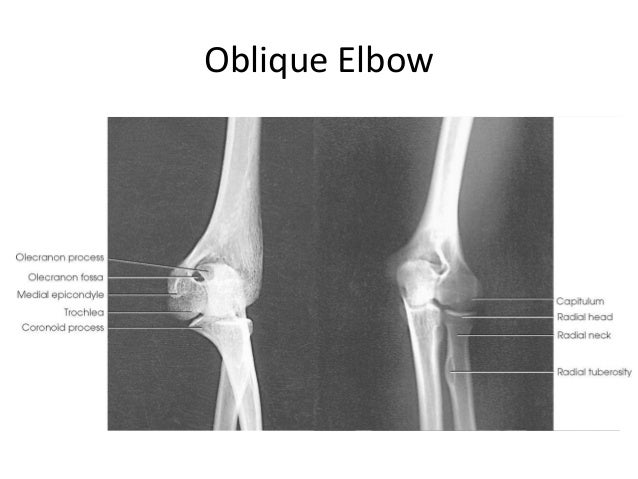
The coronoid process is seen in profile
Which bones make up the ankle mortise?

tibia, fibula, and talus
Where should the CR be directed for a lateral lumbosacral spine projection when using a 14X17in IR?
Iliac crest
Which statement most accurately describes the position of the kidneys within the abdominal cavity of an average patient?
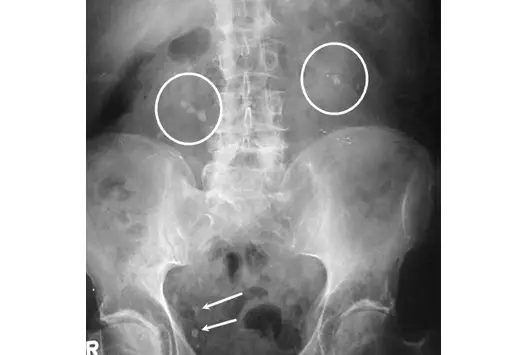
The left kidney is positioned slightly higher than the right kidney
Which finding is demonstrated most clearly by a left lateral decubitus image of the abdomen?
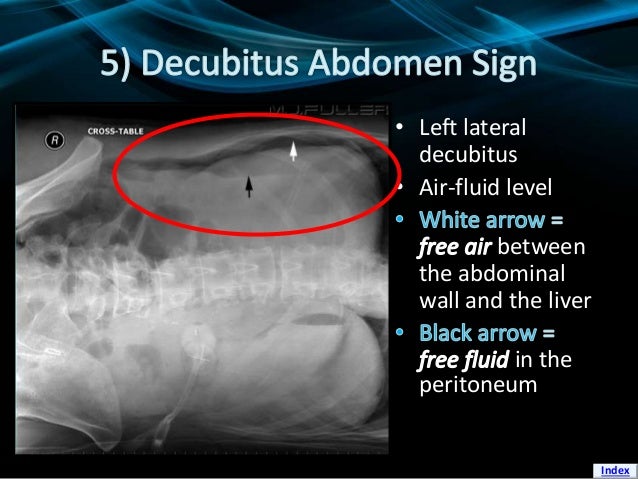
free air over the liver
Which is the correct central ray location for an AP knee?
1/2 inch below the apex of the patella
An AP shoulder image acquired with the epicondyles perpendicular to the image receptor with demonstrate which radiographic appearance?
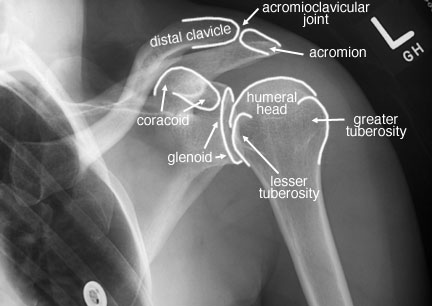
The lesser tubercle is seen in profile medially
How far should the upper border of the IR extend above the shoulders for a PA chest?
1.5-2 inches
How many posterior ribs should be visable above the diapragm on a PA chest?
10

Based on the appearance of the image, in which position was the patient placed for this postfluoroscopy image?
RAO
The RAO position, shown here, demonstrates the stomach rotated clear of the vertebral column with air in the fundus and barium in the body and pylorus. The right lateral position shows the vertebral column lateral, the LPO position demonstrates barium is in the fundus and the air is in the pylorus and the supine position shows the vertebral column in its anterior perspective.
Which structure is demonstrated without superimposition on a properly position medial oblique foot?

cuboid
Place the parts of the respiratory tract in order from the most proximal to the most distal.
- trachea
- primary bronchi
- bronchioles
- alveolar sacs
Which statement describes the presence of patient rotation on a lateral C spine image?

anterior to posterior displacement of Z joint
Which describes the appearance of a PA axial projection of the skull using the Caldwell method?
petrous pyramids in lower 1/3 or orbit
Which portion of the small intestine is most commonly affected by Crohns disease?
Ileum
Cecum is part of large intestine
Which positioning procedure is performed to demonstrate the right intervertebral foramina of the C spine?
LPO
Which appearance is demonstrated by a lateral projection of the shoulder obtained using the Lawrence method?
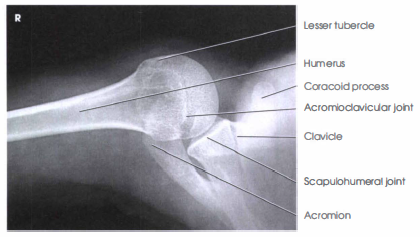
The proximal humerus is projected through the lung field
Which radiographic finding is characteristic of C spine trauma resulting in a jefferson fracture?
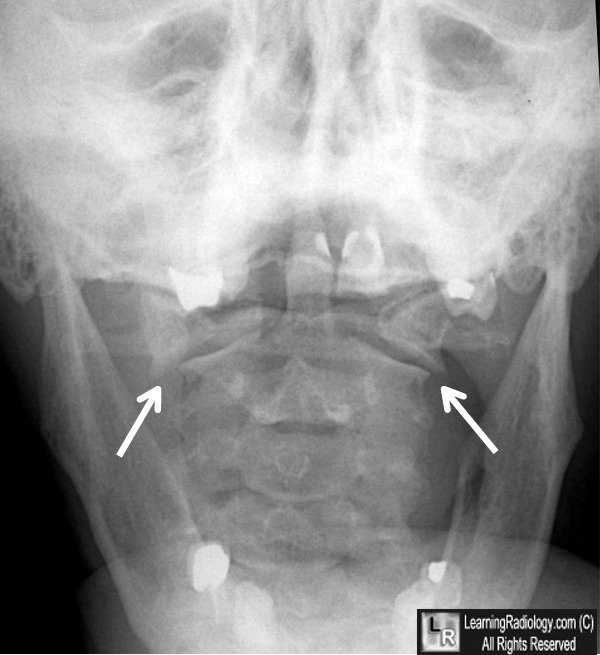
Open mouth view demonstrates a bilateral displacement of the lateral masses of C1
When is a cross table later preferred over a recumbent left lateral when obtaining images for a myelogram?
Contrast may move out of the area of interest when rolling into the lateral position
For which purpose is orthoroentgenography performed?
long bone measurement
Which method of respiration will demonstrate the maximum number of ribs above the diaphragm when performing an AP projection of the upper ribs?
suspended deep inspiration
A PA axial projection of the coccyx is performed because the patient is unable to tolerate the supine position due to injuries sustained after falling backward. How should the CR be adjusted for this projection?
10 degrees cephalad
Which anatomical structure is the most medial?
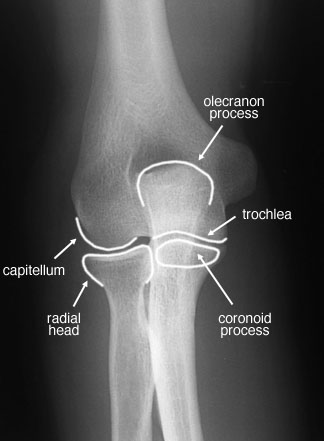
Coronoid tubercle
If a radiographic image is requested to show the nephrogram phase of an intravenous urogram, how long after IV contrast administration should this image be obtained?
30 seconds to 1 minute
The nephrogram phase of an IVU should be obtained within the first 30 seconds to one minute post injection in order to show the initial blush as contrast enters the nephrons, but has not yet reached the collecting tubules.Â
An AP pelvis image shows evidence that the patient is rotated toward the right hip. Which statement below best describes the appearance of this image?
Right iliac wing appears larger than the left iliac wing
In which exam is contrast introduced in to the area of interest in a retrograde fashion?
ERCP
Which is the correct CR location for a PA hand projection?
3rd MCP
The right RPO chest position may be used instead of the LAO position to demonstrate the heart and great vessels. How will using the RPO position affect the appearance of these structures?
The left lung appears shorter than the right
Which alternative procedure is recommended when positioning a patient for a Swimmers lateral of the cervicothoracic region if the shoulder away from the image receptor cannot be fully depressed
angle the central ray 3-5 degrees caudad
Which anatomical structure is the most distal?

Radial tuberosity
Which tarsal bone is best seen when the plantar surface of the foot is positioned perpendicular to the image receptor, and a 40 degree cephalic CR is directed to the base of the third metatarsal?
Calcaneus
Where should the CR enter the patient on an AP projection of the chest with the patient in the lateral decubitus position?
three inches below the jugular notch
Which method of respiration is recommended for a soft tissue neck exam to evaluate the trachea?
shallow breathing
What should be demonstrated on a properly exposed supine image of the abdomen?
perirenal fat
Which statement describes a properly positioned lateral foot image?
superimposition of the first and fifth metatarsal heads
Which wrist projection best demonstrates a Colles' fracture?

Lateral Wrist

...
In which position is the knee placed in order to demonstrate the head of the fibula without superimposition?
45 degrees medial rotation
Which anatomical landmark coincides with the level of CR entrance point for a PA chest radiograph?
inferior border of scapula
The alexander method is used to demonstrate dislocation of which joint?
acromioclavicular
After contrast has been administered into the hip joint during arthrography, what should the patient do?
Exercise the joint to allow the contrast to completely fill the joint space
Which is the CR location for an AP oblique projection of the urinary bladder during a cystogram?
2 inches superior to the pubic symphysis and 2 inches medial to the elevated ASIS
Which CR orientation is recommended for a standard AP axial projection of the skull to demonstrate the dorsum sellae within the foramen magnum
30 degrees to the OML
A standard AP axial projection (Towne method) of the skull is performed with the CR positioned at a 30-degree angle to the OML.
How should the CR be angled to compensate for a patient who is unable to assume the erect lordotic position for an AP axial lordotic projection of the chest?
15-20 degrees cephalic
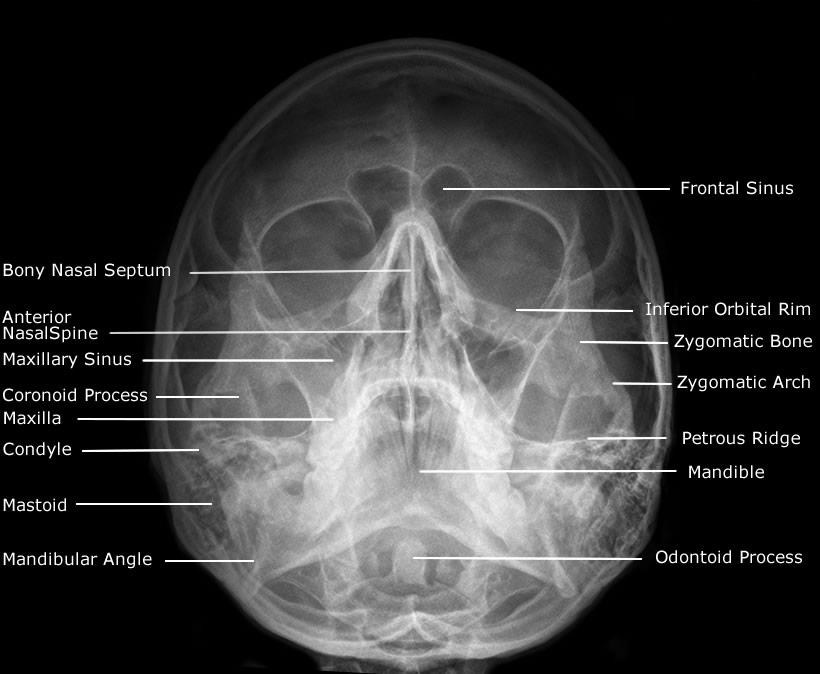
Which skull positioning line is situated perpedicular to the IR when performing a Water's method of the facial bones?

MML
this projects the petrous pyramids below the maxillary sinuses.
The appendix is connected anatomically to which structure?
cecum
Which CR angle is recommended to demonstrate the coronoid process of the elbow using the Coyle Method?
45 degrees away from the shoulder
How are the patients hand and fingers positioned for a PA wrist projection?
hand pronated with fingers flexed
At which location is the CR directed for an AP projection of the thoracic spine?
midway between the sternal notch and the xiphoid process
How should the radiographer rotate the patients lower leg and foot for an AP oblique projection of the second toe?
30-45 degrees medially
Which position/projection of the elbow best demonstrates the trochlear notch of the ulna?

lateral
Which x-ray tube orientation is used to create a 90 degree angle between the CR and the metatarsals for an AP axial projection of the foot
10 degrees posteriorly
Where should the CR enter the patient for a lateral sacrum projection?
3-4 inches posterior to the ASIS
Which projection demonstrates the Right kidney in profile?
30 degree LPO
Which projection of the foot demonstrates the cuboid bone in profile with the least bony superimposition?

medial oblique
If a patient is to undergo a small bowel series without a preceding upper upper GI series, how much barium sulfate suspension should be given?
two 250cc cups
Which is the proper amount and direction of heel rotation recommended for a PA projection of the patella?
5-10 degrees laterally
Study the four digital images of both shoulders. What best describes the quality of these images?
the degree of internal rotation was inadequate on both sides
Neither image shows the lesser tubercle in profile medially
On a radiograph of a shoulder, the greater tubercle is visualized in profile. Which projection was taken?

External rotation
There are several methods to overcome sagging of the lumbar spine in the lateral position. Where should the radiographer begin?
Assessing the line connecting spinous processes relative to the table top
Which CR angle is recommended for an AP axial projection of the toes?
15 degrees toward the heel
When performing a RAO of the sternum, a radiographer will rotate the pt 15-20 degrees. Why is this done?
to prevent superimposition of the vertebra and the sternum
A 15-20 degree rotation is used to prevent superimposition of the vertebrae and sternum. If this rotation is not used, then the spine will be blocking the sternum. Rotating the patient will not move the sternum from the shadow of the heart. The heart shadow will still be superimposed on the sternum.
Which condition may increase bowel motility?
Malabsorption syndrome
Which projection of the stomach demonstrates the duodenal bulb filled with barium and free of superimposition?
RAO
Duodenum is on right side
Place the parts of the GI tract in order from proximal to distal.
- duodenum
- jejunum
- ileum
- cecum
Which projection is freest of bony superimposition over the TMJ?
Schuller
which projection will clearly show a clay shovelers frature?

lateral cervical
What is the angle between the intervertebral foramina and the midsaggital plane in the thoracic spine?

90
Which position of the elbow will clearly demonstrate the radial neck free of ulnar superimposition?

According to Merrills Atlas where should the central be centered to best demonstrate the rami for a posteroanterior mandible projection?
acanthion
This 45 degree oblique ankle image demonstrates the calcaneus obscuring the distal aspect of the lateral mortise and distal fibula. How should the radiographer correct this image?
Dorsiflex foot
On a lateral radiograph of a patients leg, where will the patients tibia be in relation to the fibula?

partially superimposed
Only the proximal and distal ends of the two bones should be superimposed.
Which describes correct positioning for a PA chest projection? (3)
- the midcoronal plane is parallel with the IR
- The shoulders are depressed
- The shoulders are at equal distances from the IR
Correct positioning for an AP pelvis requires the lower limbs to be internally rotated until which structures are parallel with the IR?
Femoral necks
While reviewing an AP portable chest exam on the display a radiographer notices the medial ends of the clavicles are demonstrated just below the top of the apices of the lungs. Which positioning error has occurred?
The central ray angle was angled towards the head
Can the positioning of this open mouth odontoid view be improved?
No, its the best that can be achieved with this patient
On a fan lateral radiograph of a left hand, which group of bones is best visualized?
Phalanges

A radiographers critiques an AP ankle. The medial mortise joint is open while the lateral mortise joint is closed. How can the radiographer adjust the ankle to correct this image?
No correction needed
A radiographer critiques an AP image of the ribs. The left SC joint is demonstrated without vertebral column superimposition. What should the radiographer do?
Rotate patient to the right
What is the correct position of the midsagittal plane with respect to the IR when performing a true lateral projection of a skull?
parallel to the IR
Where should the radiographer direct the CR for a PA chest?
MSP 18-20 cm below the vertebral prominens

How should the radiographer correct this image of a medial oblique foot?
Increase medial rotation
Where is the anterior arch of C1?

Which exam may be used to assess cruciate ligament pathology?

knee arthrogram
Why are dorsal decubitus projections of the abdomen obtained?

to see free gas or fluid levels in the abdomen
Which bony landmark is commonly used for central ray location on an AP chest projection?
jugular notch
Which procedure is most appropriate when performing a cervical spine exam for suspected trauma on a patient on a backboard with the head immobilized?
Obtain a cross table lateral for the physician prior to further imaging

A lateral scapula image demonstrates the lateral border of the scapula next to the ribs and the vertebral border of the scapula demonstrated posterolaterally. How should the radiographer correct this image?
decrease patient obliquity
A trauma patient arrives in the radiology department on a backboard with possible trauma to the anterior chest wall. Which is the best method for obtaining an oblique sternum radiograph in this setting?
place the patient in a 15-20 degree LPO
Which position is used to demonstrate the left kidney in profile for an IVU?
30 degree RPO
When imaging the toes, how much is the central ray angled for the AP axial image?
15 degrees
What can be demonstrated with a left lateral decub position of the thorax?
Air in the Right pleural space and fluid in the left pleural space
Air up fluid down
An 82 year old female patient is transported to the x-ray dept for an exam of the right hip. The ordering physician informs the radiographer that the patient fell at home, and there is high suspicion for a femoral neck fracture. Which positioning guideline is best for the radiographer to follow?
Do not move the affected leg
Which type of fracture results from a direct blow to the front of the orbit?
Blowout
Body habitus can affect many things, including the position of the gallbladder. Place the body habitus in order from which habitus will cause the gallbladder to occupy the highest position in the abdominal cavity to the habitus that will cause the gallbladder to occupy the lowest position in the abdominal cavity.

- hypersthenic
What is the proper amount of internal leg rotation for the ankle mortise joint to appear open?
15-20 degrees
For a lateral femur, if a patient is rotated too far anteriorly, what will happen to the condyles on the distal femur?
medial condyle will be anterior to lateral condyle
Which anatomy is well visualized when the foot is is properly positioned and exposed in an axial plantodorsal projection of the heel?
an open middle talocalcaneal joint
An image demonstrates the patella superimposing the medial condyle of the knee and little superimposition between the head of the fibula and the proximal tibia. Which projection of the knee has been correctly performed?
AP with medial rotation
Which is the best projection to evaluate the coronoid process in profile?

Medial oblique elbow
To demonstrate scoliosis, which procedure is best?
Erect AP of the entire spine
A lateral knee image reveals that the femoral condyles are not superimposed with the medial condyle situated posteriorly. How should the radiographer correct this image?

Position patella closer to the IR
While performing an AP Projection of the scapula, what should be done to the patients are to move the patients scapula in a lateral direction?
abduction
What should the radiographer do to correct this image?

No correction needed
Which CR angulation is recommended to prevent foreshortening of the sacrum on an AP projection?
15 degrees cephalad
What should be done to correct positioning on an AP elbow with lateral rotation when the radial head is slightly superimposed over the proximal ulna on the first effort?

The elbow joint should be rotated laterally
The AP with lateral rotation should demonstrate the radial head, neck and tuberosity free from superimposition of the ulna
- AP
- lateral
- medial oblique
- lateral oblique
Which projection is a radiographer performing if the patients hand is turned in extreme internal rotation, with the central ray directed perpendicular to the first MCP joint?
AP thumb
Which finding is considered a contraindication for myelography?
blood in CSF
Blood in the cerebrospinal fluid indicates that there is an irritation within the subarachnoid space, which can be exacerbated by the injection of contrast medium.
Which describes the correct positioning for demonstrating the right SI joint, with the joint space open?
25 degree LPO
Upside joint is imaged
When attempting to demonstrate air-fluid levels, what is the correct central ray orientation for an AP semierect chest projection?
parallel to the floor

Which position was used to produce the image of the stomach?
LPO fundus
This is undeniably the case, as the bulk of the barium is seen in the fundus of the stomach which is the lowest part of the stomach in that position.
Where should the radiographer center to demonstrate the only point of articulation between the upper limb and the trunk?
Level of T2/T3 and 1 to 2 inches lateral from the MSP
Identify the medical condition in a patients history which should be cleared by the radiologist before the injection of an ionic, water soluble, injectable contrast agent.
Diabetes
A patient with advanced Alzheimer's disease needs to have a lung biopsy. Which condition is involved in legally obtaining informed consent to perform this procedure?
A guardian has been fully informed
Which disease is contracted by exposure to infected blood and blood products?
Hepatitis B
Contact with infected blood or blood products is necessary to transmit Hepatitis B. Tuberculosis, Smallpox, and Rubella are transmitted via airborne or airborne droplet methods.
Hep B affects the liver and is transmitted by dirty needles, sex, tattoos, razors and toothbrushes
A patient become unresponsive after receiving an injection of iodinated contrast media. The patients blood pressure is 80/50. what has likely occured?
anaphylactic shock
Which type of contrast is recommended if the patient has a perforated bowel?
Gastrografin
Gastrografin or other water soluble contrast media is used, because it is safer for Gastrografin to leak out of the bowel and into the peritoneal cavity. Isovue is expensive
If a patient with a compound fracture has an immobilization device in place, what is the best action by the radiographer?
Leave the device in place unless directed by a physician to remove it
Which condition could lead to neurogenic shock?
Head trauma
neurogenix shock is the failure of arterial resistance and causes a pooling of blood in periphery vessels
During a myelogram, a patient on the table stops breathing, and cardiac arrest is suspected. In an emergency like this where would needed equipment and supplies be found?
crash cart
Which normal effect of aging is a common obstacle to communication with elder adults?
hearing impairment
which example represents a violation of HIPAA?
Patients condition is discussed by staff in the break room
Which is an example of a violation of patients privacy?
A named patient is called for his barium enema
A patient with a history of stroke and hemiparalysis is transported to the x-ray dept by wheelchair. Which action should be taken first by the radiographer?
Place the patients strong side next to the table
A patient with a wound infection cause by MRSA should be under which precation?
Contact
Patients infected with multidrug-resistant infections such as MRSA are placed under contact precautions, which are designed to prevent the transmission of pathogens by direct skin-to-skin contact
it protects the patient
Which statement most accurately explains the typical reaction a patient can expect following the IV administration of low osmolar iodinated contrast?
You might feel a warm sensation
How can a radiographer be less intimidating to a child?
Squat down to the childs level
If a patient contracts an infectious microorganism from soiled linen, which term refers to this method of disease transmission?
Fomite
What is the proper sequencing of exams if the patient needs a BE, IVU, and thyroid uptake on the same day?
Thyroid uptake, IVU and BE
What contrast would be used for a patient who has asthma?
Iodinated nonionic
What are the three common sites for measuring the pulse of an adult patient?
Brachial radial & carotid
What is the term for the pressure in the arterial blood vessels when the left ventricle contracts?
Systolic
A step up transformer with 300 turns in the primary coil is supplied with 220 volts to this primary. How many secondary turns are needed to produce 66,000 volt output?
90,000 turns
What is the result if the total lead content of a grid is decreased?
decreased scatter absorption
In tomography, the radiographer is able to control the thickness of the slice by altering which of the following?
exposure angle
The exposure angle (A) is the arc formed by the movement of the x-ray tube
What statement is correct regarding the relationship of patient dose to EI?
EI gives an approximation of the patients dose
If all of the images from one radiographic room seem to appear excessively noisy, what might the radiographer suspect?
The AEC is set an inappropriate speed class
Which component of a diagnostic x-ray tube restricts the primary beam to the area of interest?
collimator
What is a method of electronic display resolution and quality control testing?
SMPTE
A finished radiograph has marked quantum mottle. positioning, collimation and, identification markers are correct. Which action should the radiographer take?
increase exposure factors